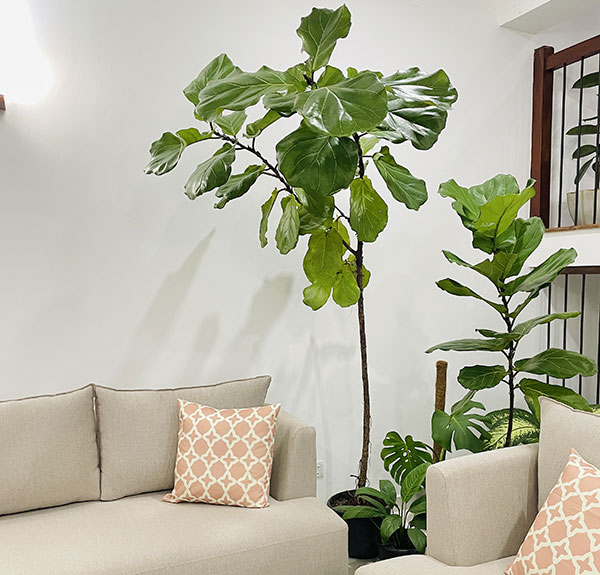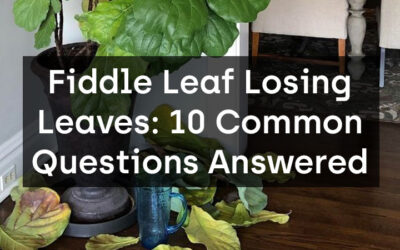Indoor houseplants are a popular choice for adding life and color to any living space, and fiddle fig leaf trees have become a particular favorite in recent years. But are these trees really good options for indoor plants? In this article, we’ll explore what fiddle fig leaf trees are, their benefits as indoor houseplants, how to care for them, and some common problems you may encounter.
Table of Contents
- What is a Fiddle Fig Leaf Tree?
- Benefits of Fiddle Fig Leaf Trees as Indoor Houseplants
- Caring for Fiddle Fig Leaf Trees Indoors
-
- Light Requirements
- Watering and Humidity
- Soil Requirements
- Fertilization
- Pruning and Maintenance
-
- Common Problems and Solutions
-
- Yellowing Leaves
- Root Rot
- Pests and Diseases
-
- Choosing the Right Fiddle Fig Leaf Tree for Your Home
- Conclusion
- FAQs
1. What is a Fiddle Fig Leaf Tree?
The fiddle fig leaf tree, also known as Ficus lyrata, is a species of fig tree native to western Africa. It is characterized by its large, violin-shaped leaves that can grow up to 18 inches in length. In its natural habitat, the fiddle fig leaf tree can reach up to 40 feet in height, but when grown as an indoor houseplant, it typically only reaches about 6 feet tall.
2. Benefits of Fiddle Fig Leaf Trees as Indoor Houseplants
Fiddle fig leaf trees have many benefits as indoor houseplants. Firstly, they are known for their attractive and distinctive appearance, with their large leaves adding a touch of elegance and sophistication to any room. They are also relatively easy to care for and maintain, making them a great option for those who may not have a lot of experience with houseplants.
In addition to their aesthetic appeal, fiddle fig leaf trees are also beneficial for indoor air quality. Like all plants, they absorb carbon dioxide and release oxygen, helping to purify the air and create a healthier living environment. Studies have also shown that having plants in your home can help to reduce stress levels and improve overall mood.

3. Caring for Fiddle Fig Leaf Trees Indoors
While fiddle fig leaf trees may be relatively easy to care for, they do require some specific conditions in order to thrive as indoor houseplants. Here are some important factors to consider when caring for your fiddle fig leaf tree:
Light Requirements
Fiddle fig leaf trees require bright, indirect light in order to grow properly. They should be placed near a window where they can receive plenty of natural light, but not in direct sunlight, which can scorch their leaves.
Watering and Humidity
Fiddle fig leaf trees prefer to be kept consistently moist, but not overly wet. Water them thoroughly once a week, allowing the soil to dry out slightly between waterings. They also require a humid environment, so it’s a good idea to mist their leaves with water regularly, or place a humidifier near the plant.
Soil Requirements
Fiddle fig leaf trees prefer well-draining soil that is rich in organic matter. You can use a commercial potting mix, or make your own by mixing equal parts of peat moss, perlite, and sand.
Fertilization
Fiddle fig leaf trees benefit from regular fertilization during the growing season (spring and summer). Use a balanced, water-soluble fertilizer every two to four weeks.
Pruning and Maintenance
Fiddle fig leaf trees require minimal pruning, but it’s a good idea to remove any dead or damaged leaves or branches as needed. They also benefit from being wiped down with a damp cloth periodically to remove any dust or debris that may have accumulated on their leaves.
4. Common Problems and Solutions
While fiddle fig leaf trees are generally easy to care for, they can still encounter some common problems. Here are some issues you may encounter with your fiddle fig leaf tree, and how to solve them:
Yellowing leaves are a common problem with fiddle fig leaf trees, and can be caused by a variety of factors including overwatering, underwatering, lack of sunlight, or pest infestations. To solve this issue, it’s important to identify the underlying cause and adjust your care routine accordingly.
Fiddle fig leaf trees are susceptible to root rot, which can be caused by overwatering or poor soil drainage. If you notice that your tree’s leaves are wilting or turning yellow, and the soil is overly wet, you may have a root rot problem. To solve this, you’ll need to remove the affected roots and repot the tree in fresh, well-draining soil.
- Pests and Diseases
Fiddle fig leaf trees can also be susceptible to pest infestations and diseases, such as spider mites, scale insects, or fungal infections. To prevent these issues, it’s important to keep your tree clean and healthy, and to inspect it regularly for any signs of infestation or disease. If you do encounter pests or disease, there are a variety of natural and chemical treatments available.
5. Choosing the Right Fiddle Fig Leaf Tree for Your Home
When selecting a fiddle fig leaf tree for your home, there are a few factors to consider. Firstly, you’ll want to choose a healthy, well-established tree with no signs of damage or disease. You’ll also need to consider the size and shape of your tree, as well as its growth habits, in order to ensure that it will fit well in your space and be easy to care for.
6. Conclusion
In conclusion, fiddle fig leaf trees can be a great option for indoor houseplants, with their attractive appearance, easy care requirements, and benefits for indoor air quality. By following the care guidelines outlined in this article, and being aware of common problems and solutions, you can enjoy the beauty of this unique tree in your home for years to come.
7. FAQs
1. How often should I water my fiddle fig leaf tree?
Fiddle fig leaf trees prefer to be kept consistently moist, but not overly wet. Water them thoroughly once a week, allowing the soil to dry out slightly between waterings.
Fiddle Leaf Figs should be watered when the top 2-3 inches of soil are dry to the touch.
2. Can fiddle fig leaf trees survive in low light conditions?
3. What should I do if my fiddle fig leaf tree's leaves are turning brown?
Brown leaves can be a sign of overwatering or underwatering, as well as lack of humidity or exposure to cold drafts. Identify the underlying cause and adjust your care routine accordingly.
4. Can I grow a fiddle fig leaf tree from a cutting?
Yes, fiddle fig leaf trees can be propagated from stem cuttings. Simply take a cutting from a healthy tree, root it in water or soil, and provide the same care requirements as a mature tree.







0 Comments